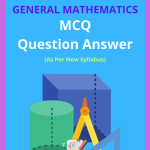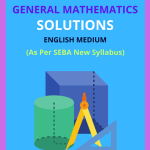SEBA Class 10 Mathematics Chapter 1 Real Numbers Solutions, SEBA Class 10 Maths Textbook Notes in English Medium, SEBA Class 10 Mathematics Chapter 1 Real Numbers Notes in English to each chapter is provided in the list so that you can easily browse throughout different chapter Assam Board SEBA Class 10 Mathematics Chapter 1 Real Numbers Notes and select needs one.
SEBA Class 10 Mathematics Chapter 1 Real Numbers
Also, you can read the SCERT book online in these sections Solutions by Expert Teachers as per SCERT (CBSE) Book guidelines. SEBA Class 10 Mathematics Chapter 1 Real Numbers Question Answer. These solutions are part of SCERT All Subject Solutions. Here we have given SEBA Class 10 Mathematics Chapter 1 Real Numbers Solutions for All Subject, You can practice these here.
Real Numbers
Chapter – 1
| Exercise 1.1 |
1. Use Euclid’s division algorithm to find the HCF of:
(i) 135 and 225
Ans: Since 225 > 135, we apply the division lemma to 225 and 135,
We have 225 = 135 × 1 + 90
Since the remainder 90 ≠ 0, so we apply division lemma to 135 and 90,
We have 135 = 90 × 1 + 45
Again remainder 45 ≠ 0, so we again apply division lemma to 90 and 45,
We have 90 = 45 × 2 + 0
The remainder has now become zero.
So our procedure stops Since the divisor at this stage is 45,
Hence HCF of 225 and 135 is 45. i.e. HCF (225,135) = 45.
(ii) 196 and 38220
Ans: By Euclid division lemma to 196 and 38220
we have 38220 = 196 × 195 + 0
The remainder has now zero.
Hence HCF of 196 and 38220 is 196
(iii) 867 and 225
Ans: By Euclid Division Algorithm, we have 867 = 255 × 3 + 102
We apply the Euclid Division Algorithm on the division 255 and the remainder 102.
225 = 102 × 2 + 51 on the division 102
Again we apply Euclid’s Division Algorithm remainder 51, 102 = 51 × 2 + 0 HCF (867, 255) = 51.
(iv) 272 and 1032
Ans: By Using Euclid Division Algorithm
1032 = 272 × 3 + 216
272 = 216 × 1 + 56
216 = 56 × 3 + 48
56 = 48 × 1 + 8
48 = 8 × 6 + 0
The remainder has now become zero, So, our procedure stops.
Since the divisor at this stage is 8.
∴ HCF of 272 and 1032 is 8
(v) 405 and 2520
Ans: Using Euclid Division Algorithm
2520 = 405 × 6 + 90
405 = 90 × 4 + 45
90 = 45 × 2 + 0
The remainder has now become zero, So, our procedure stops.
Since the divisor at this stage is 45
∴ The HCF of 405 and 2520 is 45.
(vi) 155 and1385
Ans: Using Euclid Division Algorithm
1385 = 155 × 8 + 145
155 = 145 × 1 + 10
145 = 10 × 14 + 5
10 = 5 × 2 + 0
The remainder has now become zero, So, our procedure stops.
Since the divisor at this stage is 5.
∴ The HCF of 155 and 1385 is 5.
(vii) 384 and 1296
Ans: Using Euclid Division Algorithm
1296 = 384 × 3 + 144
384 = 144 × 2 + 96
144 = 96 × 1 + 48
96 = 48 × 2 + 0
The remainder has now become zero, So, our procedure stops.
Since the divisor at this stage is 48.
∴ HCF of 384 and 1296 is 48
(viii) 1848 and 3058
Ans: Using Euclid Division Algorithm
3058 = 1848 × 1 + 1210
1848 = 1210 × 1 + 638
1210 = 638 × 1 + 572
638 = 572 × 1 + 66
572= 66 × 8 + 44
66 = 44 × 1 + 22
44 = 22 × 2 + 0
The remainder has now become zero,
So,our procedure stops.
Since the divisor at this stage is 22
∴ HCF of 1848 and 3058 is 22
2. Show that any positive odd integer is of the form 6q + 3 or 6q + 5, where q is some integers.
3. An army contingent of 616 members is to march behind an army band of 32 members in a parade. The two groups are to march the same number of columns. What is the maximum number of columns in which it can march?
Ans: The maximum number of columns is the HCF of 616 and 32.
In order to find the HCF of 616 and 32, let us apply Euclid’s division lemma to 616 and 32 to get 616 = 32 × 19 + 8
Let us take the divisor 32 as dividend and remainder 8 as divisor and apply Euclid’s division lemma to get 32 = 8 × 4 + 0
Since the remainder at this stage is 0. Therefore the last division i.e. 8 is the HCF of 616 and 32.
Hence, the maximum number of columns in which they can march is 8.
4. Use Eucild’s division lemma to show that the square of any positive integer is either of the form 3m or 3m + 1 for some integer m.
5. Use uclid’s division lemma to show that the cube of any positive integer is of the form 9m, 9m + 1 or 9m + 8
6. Himadri has a collection of 625 Indian postal stumps and 325 International postal stumps. She wants to display them in identical groups of Indian and International stumps with no stumps left out. What is the greatest number of groups Himadri can display the stumps?
Ans: Using Euclid Division Algorithm 625 = 325 × 1 + 300
325 = 300 × 1 + 25
300 × 12 + 0
The remainder has now become zero, So,our procedure stops.
Since the divisor at this stage is 25.
∴ HCF of 325 and 625 is 25
∴ Greatest number of groups of postal stumps is 25.
7. Two ropes are of length 64cm and 80cm. Both are to be cut into pieces of equal length. What should be the maximum length of the pieces?
Ans: HCF of 64 and 80 will be the maximum length of the pieces. Now, we are to required HCF of 64 and 80
Using Euclid Division Algorithm
80 = 64 × 1 + 16
64 = 16 × 4 + 0
The remainder has now become zero, So,our procedure stops. Since the divisor at this stage is 16
∴ HCF of 64 and 80 is 16
∴ Minimum length of pieces = 16cm.
| Exercise 1.2 |
1. Express each number as a product of its prime factors:
(i) 140
Ans:
∴ 140 = 2 × 2 × 5 × 7 = 22 × 5 × 7
(ii) 156
Ans:
(iii) 3825
Ans:
∴ 3825 = 3 × 3 × 5 × 17
(iv) 5005
Ans:
∴ 5005 = 5 × 7 × 11 × 13
(v) 7429
Ans:
∴ 7429 = 17 × 19 × 23
2. Find the LCM and HCF of the following pairs of integers and verify that LCM × HCF = product of the two numbers.
(i) 26 and 91
Ans: we have 26 and 91
Thus LCM (26, 91) = 2 × 7 × 13 = 182
HCF (26, 91) = 13
Now LCM (26, 91) × HCF (26, 91 ) = 182 × 13 = 2366
And product of the numbers = 26 x 91 = 2366.
Hence the LCM × HCF = product of two numbers.
(ii) 510 and 92
Ans: We have 510 and 92
510 = 2 × 35
92 = 22 × 23
∴ LCM (510, 92 ) = 22 × 35 × 23 = 23460
HCF (510, 92) = 2
Now LCM (510, 92) × HCF (510, 92) = 23460 × 2 = 46920
Product of two numbers = 510 × 92 = 46920
Hence LCM x HCF = Product of two numbers.
(iii) 336 and 54
Ans: We have 336 = 2⁴ × 3 × 7 54 = 2 × 3³
HCF (336, 92) = 2 × 3 = 6
Now LCM (336, 54) × HCF (336, 54) = 3024 × 6 = 18,144 and product of two numbers = 336 × 54
= 18,144
Hence LCM × HCF = product of two numbers.
3. Find the LCM and HCF of the following integers by applying the prime factorisation method.
(i) 12, 15 and 21
Ans: (i) 12 = 22 × 3 15 = 3 × 5 and 21 = 3 × 7
∴ The HCF of these integers is 3
22, 31, 51 and 71 are the greatest powers involved in the prime factors of 12, 15 and 21.
So LCM (12, 15, 21) = 22 × 31 × 51 × 71 = 420
(ii) 17, 23 and 29
Ans: 17, 23 and 29
There is no common factor as 17,23,29 they are primes. Hence HCF is 1.
LCM is the product of all prime factors 17, 23, 29 = 17 × 23 × 29 = 11339
∴ HCF (17, 23, 29) = 1
(iii) 8, 9 and 25
Ans: 8, 9 and 25
8 = 2 × 2 × 2 = 23 9 = 32 25 = 52
∴ HCF (8, 9, 25) = 1 [∵ There is no common factor of 8, 9, 25]
LCM = 23 × 32 × 52 = 1800
4. Given that HCF (306, 657) = 9, find LCM(306, 657)
Ans: We have
HCF (306, 657) = 9
We know that, LCM × HCF = Product of two numbers.
306 × 657
LCM × 9 = 306 × 657
306 × 657/9 = 22338
LCM = 22338
5. Check whether 6n can end with the digit 0 for many natural numbers n.
Ans: If the number 6n ends with the digit zero, then it must have 5 as a factor.
But, we know that the only prime factors of 6n are 2 and 3.
Also, we know from the fundamental theorem of arithmetic, that the prime factorisation of each number is unique.
So, there is no value of n natural numbers for which 6n ends with the digit zero.
6. Explain why 7 × 11 × 13 + 13 and 7 × 6 × 5 × 4 × 3 × 2 × 1 + 5 are composite numbers.
Ans: We have 7 × 11 × 13 + 13 = 1001 + 13 = 1014
1014 = 2 × 3 × 13 × 13
So, it is the product of prime factors, 2 × 3 × 13 × 13
Hence, it is a composite number.
7 × 6 × 5 × 4 × 3 × 2 × 1 + 5 = 5 × (7 × 6 × 4 × 3 × 2 × 1 + 1)
= 5 × 1009.
= 5045 Thus 5045 can be expressed as products of primes.
It is the of prime factor 5 × 1009
Hence it is a composite number.
7. There is a circular path around a sports field. Sonia takes 18 minutes to drive one round of the field, while Ravi takes 12 minutes for the same. Suppose they both start at the same point and at the same time, and go in the same direction. After how many minutes will they meet again at the starting point?
Ans: Required number of minutes is the LCM of 18 and 12
We have, 18 =2 × 3² 12 = 22 × 3
∴ LCM of 18 and 12 is 22 × 32 = 36
Hence, Ravis and Sonia will meet again at the starting point after 36 minutes.
8. The soldiers in the regiment can be stood in some rows consisting of 15, 20 and 25 numbers of soldiers . find the least number soldiers in the regiment.
Ans: Least numbers of soldiers in the regiment = LCM (15, 20, 25)
Now, 15 = 3 × 5
20 = 22 × 5
25 = 52
∴ LCM (15, 20, 25) = 3 × 22 × 52
= 3 × 4 × 25
= 300
∴ 300 Soldier in the regiment.
(ii) A bell rings at every 18 seconds, another bell rings at every 60 seconds. If these two bells ring simultaneously at an instant, then find after how many seconds will the bells ring simultaneously again.
Ans: Required second = LCM (18, 60)
Now, 18 = 2 × 32
60 = 22 × 3 × 5
∴ LCM (18, 60) = 22 × 32 × 5
= 4 × 9 × 5
= 180
∴ After 180 seconds will the bells rings simultaneously again.
(iii) A radio station plays ‘Assam Sangeet’ once every two days. Another radio station plays the same song once every three days. How many times in 30 days will both the radio station play the same song on the same day.
Ans: One radio’s station plays ‘Assam Sangeet’ once every 2 days another radio station plays the same songs once every 3 days
LCM of (2, 3) = 6
∴ In 30 days both the radio stations play the same song on the same day = 30/6 = 5 times.
| Exercise 1.3 |
1. Prove that √5 is an irrational number.
Ans: Let √5 represents a rational number.
Then √5 can be expressed have no common factor, q ≠ 0. in the form, where p,q are integers and have no common factor q
2. Prove that 3 + 2√5 is irrational:
Ans: Let us assume on the contrary that 3 + 2 sqrt(5) is rational. Then there exist co-prime positive integers a and b (b ≠ 0) such that
3 + 2 √5 = a/b ⇒ 2 √5 = a/b -3 ⇒√ 5 = a – 3b/2b
⇒ √ 5 is rational { ∴ a,b are integers ∵ a – 3b/2b is rational}
This contradicts the fact that √ 5 is irrational. So our supposition is incorrect.
Hence 3 + 2 √ 5 is an irrational number.
3. Prove that the following irrationals.
(i) 1/√2
(ii) 7√5
(iii) 6 + √2
Ans: Let 6 + √2 be a rational number equal to a/b
where a, b are positive co-primes. Then,
This is a contradiction.
Hence, 6 + √2 is irrational.
| Exercise 1.4 |
1. Without actually performing the long division, state whether the following rational numbers will have a terminating decimal expansion or a non-terminating repeating decimal expansion:
(i) 13/3125
Ans: Since the factors of the denominator 3125 is of the form 20 × 55. Therefore 13/3125 is a terminating decimal.
(ii) 17/8
Ans: Since the factors of the denominator 8 is 23 × 50. So 17/8 is a terminating decimal.
(iii) 64/455
Ans: Since the factor of the denominator 455 is not in the form 2n × 5m. So 64/455 is non-terminating repeating decimal.
(iv) 15/1600
Ans: Since the factors of the denominator 1600 is of the form 26 × 52. So, 15/1600 is a terminating decimal.
(v) 29/343
Ans: Since the factors of the denominator 343 is not of the form 2n × 5m . So, 29/343 is non-terminating repeating decimal.
Ans: Since the denominator is of the form 23 × 52. So, 23/(23 × 5 2) is a terminating decimal.
Ans: Since the factors of the denominator 225775 is not of the form 2n × 5m. So, 129/(22 × 57 × 75) is a non-terminating repeating decimal.
(viii) 6/15
Ans: 6/15 = 2/5 here the factors. So, 6/15 is a terminating decimal of the denominator 5 is of the form 20 × 51
(ix) 35/50
Ans: Since the factors of the denominator 50 of the form 21 × 52. So, 35/50 is terminating decimal.
(x) 27/210
Ans: Since the factors of the denominator 210 are not of the form 2n × 5n. So, 77/210 is non-terminating repeating decimal.
2. Write down the decimal expressions of those rational numbers in question 1 above which have terminating decimal expansions.
3. The following real numbers have decimal expansion as given below. In each case, decide whether they are rational or not. If they are rational, and of the form p/q , what can you say about the prime factors of q?
Ans: Rational q = 109 = 29 × 59 (ii) non-rational (iii) Rational, prime factors of q will also have factors other than 2 or 5 because the decimal is non-terminating repeating.

Hi, I’m Dev Kirtonia, Founder & CEO of Dev Library. A website that provides all SCERT, NCERT 3 to 12, and BA, B.com, B.Sc, and Computer Science with Post Graduate Notes & Suggestions, Novel, eBooks, Biography, Quotes, Study Materials, and more.







